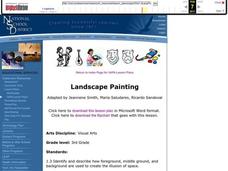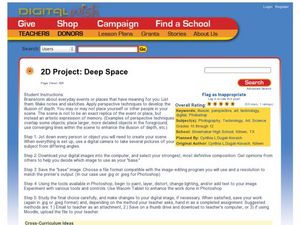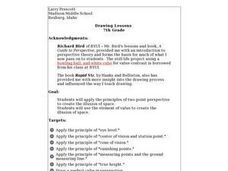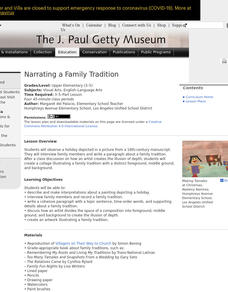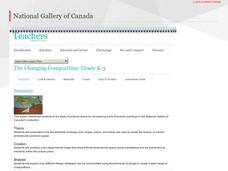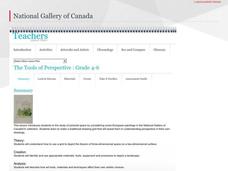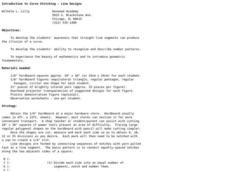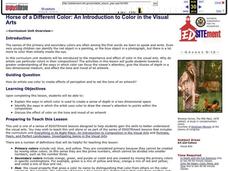National Gallery of Canada
My Upside-Down World!
M.C. Escher is famous for creating optical illusions. Examine this effect in several of his works and discuss the techniques involved. Inspired by the discussion, learners create an imaginary 3-D world inside of a box using various...
Curated OER
Does Negative Space Have A Shape?
Students observe negative space in drawing. In this negative space lesson, students discover that sketches include negative space or background. Students produce a drawing while paying attention to the negative space.
Curated OER
Landscape Painting
Third graders paint a landscape that demonstrates the illusion of space. In this visual arts lesson plan, 3rd graders paint a creek with reflections as the focus and include images showing foreground, middle ground, and...
Curated OER
People and Space
Students eat dehydrated foods that the astronauts would eat in space. In this dehydrated foods lesson plan, students make lists of food they could eat, discuss how dehydration takes place, eat food, and complete discussion questions.
Curated OER
An Introduction To Pictorial Space
Students draw a picture of a landscape using techniques that create the illusion of space. They then transform this landscape drawing into a three-dimensional form, which depicts a mood or an emotion.
Curated OER
Illusions of Depth
Third graders practice drawing a landscape to show an illusion of depth. In the drawing, they can put whatever objects they choose to but have to remember to show depth. They explain how overlapping and size differences show...
Digital Wish
2D Project: Deep Space
Using a digital camera, Photoshop, and a desktop paint program, learners will explore perspective techniques. They apply perspective techniques to develop depth illusions within a scene. The lesson employs both traditional art and...
Curated OER
Fraggle Monster Vase
Students create an optical illusion. In this optical illusions instructional activity, students sketch a monster's face to create the optical illusion of a vase in the positive space. Students create an original piece of art.
Curated OER
Drawing Lessons
Seventh graders complete a visual acts project that focuses on eye level, center of vision, station point, cone of vision, vanishing points, true height, and drawing a box in two point perspective. They work on a number of still life...
Exploratorium
Far Out Corners
Construct a three-dimensional optical illusion when your class is exploring vision and how the eye and brain work together. Three concave corners are mounted inside of a black box, but as a light is shined upon them, they appear to be...
LABScI
Vision Lab: The Eye
Our bodies have some amazing capabilities, but there are some limitations. Explore the limitations of the human eye through the eighth lab activity in a series of 12 biology lessons. Individuals measure their own peripheral vision...
Curated OER
Cast of characters -- Lost in Space Lesson
Students examine how artists use the picture plane to depict two and three dimensions. They view online images, discuss how space is used to depict three-dimensional space, and create a painting.
J. Paul Getty Trust
Narrating a Family Tradition
After examining a piece of art, scholars discuss what they see, paying close attention to details and space. A read-aloud introduces the topic of family traditions. Pupils interview their family members about a tradition in preparation...
Curated OER
Exploring the Deep: Creating Space and Distance
Young scholars explore perspective and color techniques to create the illusion of three-dimensional space in two-dimensional works. They create three-dimensional landscapes.
Curated OER
Eye-Popping Op Art
Students examine and discuss work of Hungarian artist Victor Vasarely, recognize visual components of Op Art, compare traditional Renaissance perspective with Op Art's illusion of three-dimensional space, and create original painting...
National Gallery of Canada
The Changing Composition
Play with dimensions and practice making a two-dimensional scene look three-dimensional. Class members view pieces of art and then make their own scenes by layering different materials and drawing in details. Check out all the tabs for...
National Gallery of Canada
The Tools of Perspective
Make a study of perspective in the real world. Learners examine and discuss works of art that show examples of perspective before trying their own hands at it. Using a grid drawn on transparent paper, class members transfer a view from a...
Curated OER
Dimensional Space: Various Perspectives
Learners use their understanding of 3D on 2D to make a representation of a 4D form on paper.
Curated OER
Mixed Media Weaving
Students will demonstrate the ability to create the illusion of space by overlapping shapes.They will recognize the differences between art materials, techniques, and processes. Students will demonstrate the influence of personal...
K12 Reader
The Art of M.C. Escher
Show your class one way in which art and math are related by teaching them about M.C. Escher. Class members read a brief passage and then respond to five related questions.
Curated OER
Introduction to Curve Stitching - Line Designs
Students develop their awareness that straight line segments can produce the illusion of a curve and helps them recognize and describe number patterns and geometric fundamentals.
Curated OER
Body Image
Students read and answer questions on neural processing and the Pinocchio Illusion. They relate and discuss these topics in conjunction with body-image disorders such as anorexia and bulimia . This lesson include video extension activities.
Curated OER
Horse of a Different Color: An Introduction to Color in the Visual Arts
Students examine how artists use color to create a sense of depth in a two-dimensional space. They view and analyze prints, complete worksheets, and write a paragraph on how color is used to draw the viewer's eye to a central figure.
Curated OER
A DISAPPEARING ACT Astronomy: Do Stars Always Shine?
Students observe why stars are not visible during the day with a classroom demonstration using an index card punched with holes.




